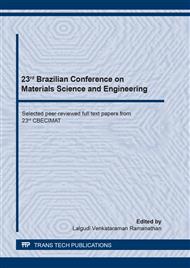p.233
p.239
p.244
p.250
p.256
p.262
p.268
p.272
p.278
Study of the Potential of Adhesion to the Substrate of Masonry and Tensile in the Flexion in Mortars of Coating with Gray of the Sewage Sludge
Abstract:
This work evaluates mortars using sewage sludge calcined at temperatures of 600°C and 700°C as a hydraulic binder replacing the cement. The percentages incorporated by mass to replace the Portland cement were 10%, 20% and 30%, using the 1:3:0,60 (cement: sand: factor a/c) trace. Sludge ash was characterized and tensile strength at flexion as well as tensile strength (pullout test) were evaluated. As a way of performing a comparison with conventional mortars, the same tests were carried out using reference mortar. The results of the flexural tensile strength tests indicated that results were higher than the reference traces of the mortars with the calcined sludge at a temperature of 700°C, a factor related to the increase of the calcination temperature and the incorporated percentage. With respect to the tests on the determination of tensile strength, it was observed that the specimens submitted to the test suffered rupture in the mortar, and that the calcination temperature of the sewage sludge was not influenced. The results obtained with the mortars using sewage sludge ash with partial replacement of the cement are shown within the normative standards and approximate to the results obtained with the tests executed with the reference mortar.
Info:
Periodical:
Pages:
256-261
Citation:
Online since:
October 2020
Keywords:
Price:
Сopyright:
© 2020 Trans Tech Publications Ltd. All Rights Reserved
Share:
Citation:


